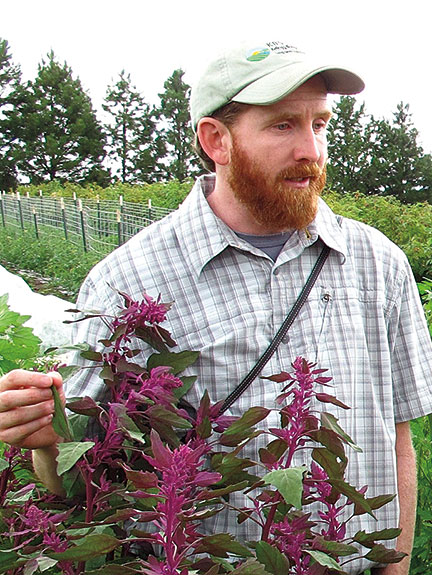As small, relatively obscure seeds go, quinoa has a lot riding on it.
It measures about 3 millimeters across, and its worldwide production is about 1/20,000th of wheat, but foodies, researchers, farmers, grocers, and food policy experts can’t get enough of it. Packed with protein, adaptable, and hardy, it’s an emerging option in the quest to improve farm incomes while feeding a growing planet with impoverished soils and warming temperatures. The United Nations General Assembly has even given it its own year: 2013, the “International Year of Quinoa.” UN Secretary-General Ban Ki-moon last February said it is “truly a food for the Millennium Development Goals,” which include cutting world-wide hunger in half by 2015.
Sure. No pressure.
Rising to the task is Kevin Murphy ’04 MS, ’07 PhD, a WSU plant breeder and director of a four-year, $1.6 million project to develop varieties and practices for growing quinoa in diverse environments. Sponsored by the National Institute of Food and Agriculture’s Organic Agriculture Research and Extension Initiative, the project is one of the largest yet to bring quinoa from the Andean highlands to North America and the rest of the world.

The effort has the usual challenge of finding varieties best suited to the climate, soils, and other growing conditions of, say, the Palouse or western Washington, while at the same time setting up some sort of processing system. The market for quinoa is already eager and growing, with the price rising five-fold since 2005.
“The increased interest of the market has now become global,” says Sven-Erik Jacobsen. The Danish scientist, who has quinoa projects on three continents, was a keynote speaker this summer at the International Quinoa Symposium held in Pullman and organized by Murphy.
But the world interest in quinoa brings up an additional challenge: how to satisfy international markets without dominating and driving poor South American growers deeper into poverty.
Andean growers have worked with quinoa (pronounced: keen-WAH) for 7,000 years, says Murphy, with a diverse number of varieties adapted to the region’s poor soils and high altitude. Murphy himself first ate quinoa in 1993 while living for five months with an Ecuadoran family that served a soup of quinoa, potatoes, and pork fat most nights of the week.
Back in the states, he grew it on an organic vegetable farm in Port Townsend, where it did so well that Community Supported Agriculture subscribers wanted to make the seed heads part of their free flower bouquets.
“They always wanted to pick the quinoa because it was so beautiful,” he says. “We had to fight them off.”
In 2009, he heard a Bolivian agronomist talk about Andean farmers meeting a rising demand for quinoa by shifting from a rotation of llama grazing, potatoes, and quinoa to successive years of quinoa. The soil was being degraded, yields were dropping, and pests and diseases were on the rise.
“When I heard him describe the situation, I thought we should really try growing it up here to see if U.S. farmers can grow it and alleviate some of that pressure,” Murphy says.
He and his colleagues now have test plots of various sizes on the Palouse and the Olympic Peninsula, as well as in Prosser, Oregon, Idaho, and Utah, where Utah State University’s Jennifer Reeve ’03 MS, ’07 PhD is screening quinoa breeding lines for salt tolerance in the state’s high saline soils.
“When to plant, how dense to plant, those are all questions we really don’t know the answers to yet,” Murphy says. “So we want to make as many mistakes as we can before farmers start trying and making mistakes.”
That said, Murphy says there’s a strong likelihood the project will quickly develop good varieties that could find homes on both the Palouse and among west-side vegetable growers eager to diversify their rotations.
The long-term prospects of quinoa and its South American growers are harder to gauge and was a lively topic during the three-day international symposium.
Willy Choque Marca, one of several Bolivian farmers in attendance, says the growing market and price for quinoa was reducing poverty and luring young people back to the countryside. But he said growers face a challenge going from a boom economy to a stable one.
Sergio Nunez de Arco of Andean Naturals, a marketing firm with an eye on quinoa growers’ viability, says it’s likely that the rest of the world will eclipse South America’s quinoa output and sell it for less. But Andean farmers can get a premium price by marketing “a face and a place,” tying the product to the people growing it and how it improves their lives.
“We have to de-commoditize quinoa,” says Nunez de Arco, a Bolivian native educated at the University of California, Berkeley.
Murphy agrees.
“Quinoa is coming,” he says. “We’ve figured that out. It’s not going to go away. But we have to figure out how to grow it here responsibly and on a scale that will let Andean farmers continue to grow it and sell it profitably. And we also need to help figure out ways that Andean farmers can label and market their quinoa so that, like the Walla Walla onion, there’s name recognition and added value to traditionally grown Andean quinoa.”
